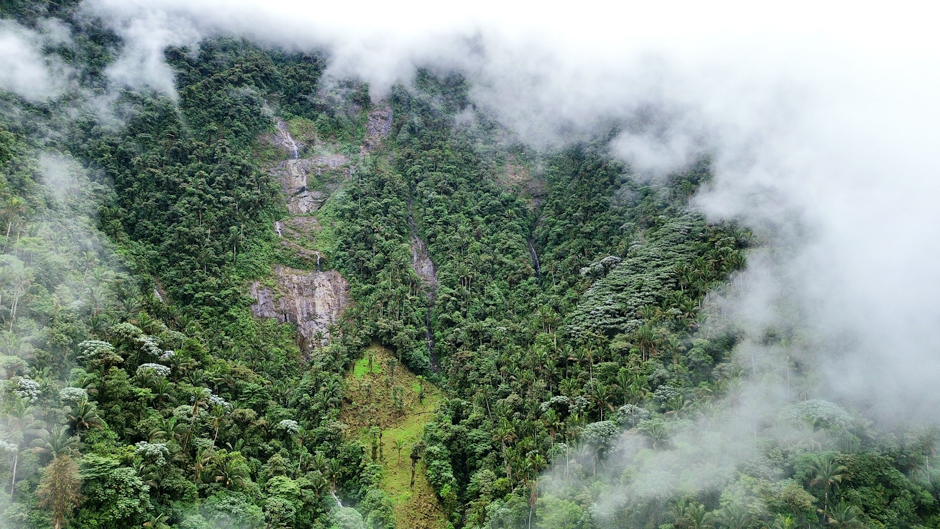One of the largest modern plant extinction events was reported in the Andean hills of Ecuador 33 years ago.
Yet, new research from a team of international ecologists, including two from the University of Miami, shows that rare plants and trees found in the tropical cloud forests may be more resilient than once believed.
In the early 1980s, renowned ecologists Alwyn Gentry and Calaway Dodson discovered what they considered one of the most biodiverse places on Earth—cloud forest hilltops in western Ecuador teeming with plant and animal species no scientist had encountered anywhere else. Wedged between the Andes Mountains and the Pacific Coast, the ecologists’ description of the Centinela forest helped elevate the region among tropical botanists across the globe.
But when they returned a decade later, in 1991, Gentry and Dodson were devastated to find that much of the area they celebrated had been transformed from forests into farms. They concluded that many of the 90 rare “Centinelan” species they discovered had gone extinct.
Over the past three years, a team of ecologists and botanists from 14 institutions, including Kenneth Feeley, a biology professor in the College of Arts and Sciences, and biology graduate student Riley Fortier, decided to try and find some of these species and learned that all but one of the species that Gentry and Dodson claimed to have gone extinct are actually still alive today. Published Oct. 15 in Nature Plants, their research turns the idea of a “Centinelan extinction,” coined by ecologist E.O. Wilson, on its head.
“The whole idea of Centinela and Centinelean extinctions was that there were these microendemics, or plant species, that could not be found anywhere else in the world, that would be rapidly lost through land use change. But through our research, we found that some of these species actually occur far outside of Centinela. And since the deforestation was not complete, some endemic species were able to persist in the remaining patches of forest,” said Feeley, the University’s Smathers Chair of Tropical Tree Biology and director of the John C. Gifford Arboretum. “Maybe some species are more resilient than we give them credit for, and after we think they are all lost, some might still be out there hanging on.”
Before arriving at this new conclusion, the research team spent years traveling to the Centinela region, collaborating with experts on tropical flora and combing through plant archives called herbaria to detect whether any of the endemic species that Gentry and Dodson identified may have avoided extinction. Led by Dawson White, a postdoctoral researcher at Harvard University, along with Nigel Pitman, a botanist at the Field Museum of Natural History in Chicago, Feeley and colleagues helped compare the plants in Gentry and Dodson’s records with the ones that White, Pitman, and other team members identified in the field, along with those in herbaria and now available through online databases.
They were happily surprised to find that 99 percent of the species expected to be extinct were still around, including the rare Gasteranthus extinctus, an orange flowering plant prematurely named for its extinction, which Fortier helped rediscover on a 2021 expedition to Centinela. Also, within the nearly two dozen small patches of forest that remain in Centinela, they identified and described eight plant species that are new to science, including a large canopy tree.
“Many of Centinela’s plants are still on the brink of extinction, but fortunately the reports of their demise were exaggerated,” said White. “There’s still time to save them and turn this story around.”
Feeley, White, Pitman, and their co-authors recognize that the work of herbaria, as well as the convenience of modern technology—particularly the Global Biodiversity Information Facility database—was critical to help them.
“It takes decades of work from taxonomic experts to describe new species in such forests,” said White. “Only once we have names for these species and they get plugged into our scientific networks can we begin to understand where else these plants grow and their risk of extinction.”
Now that this information is public, Feeley and Fortier hope that the government of Ecuador will be eager to conserve the patches of Centinela that remain.
“Hopefully this paper will bring attention back to this important area that conservationists had all but given up on before,” Feeley said. “But on a larger scale, we need to continue to study these high-diversity areas to better understand how species are being affected by deforestation, and if some of the species we think are lost may actually still be out there and in desperate need of protection. More work and vigilance are required to find out the status of things, so we can best direct our future conservation efforts.”

